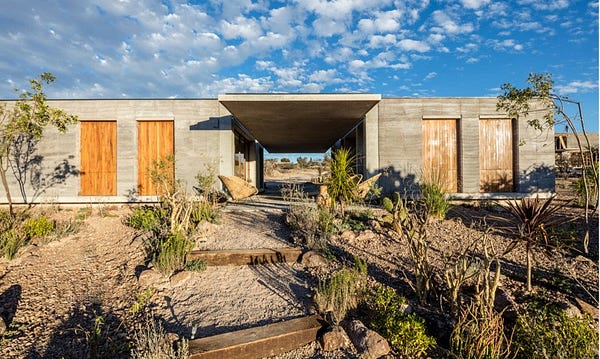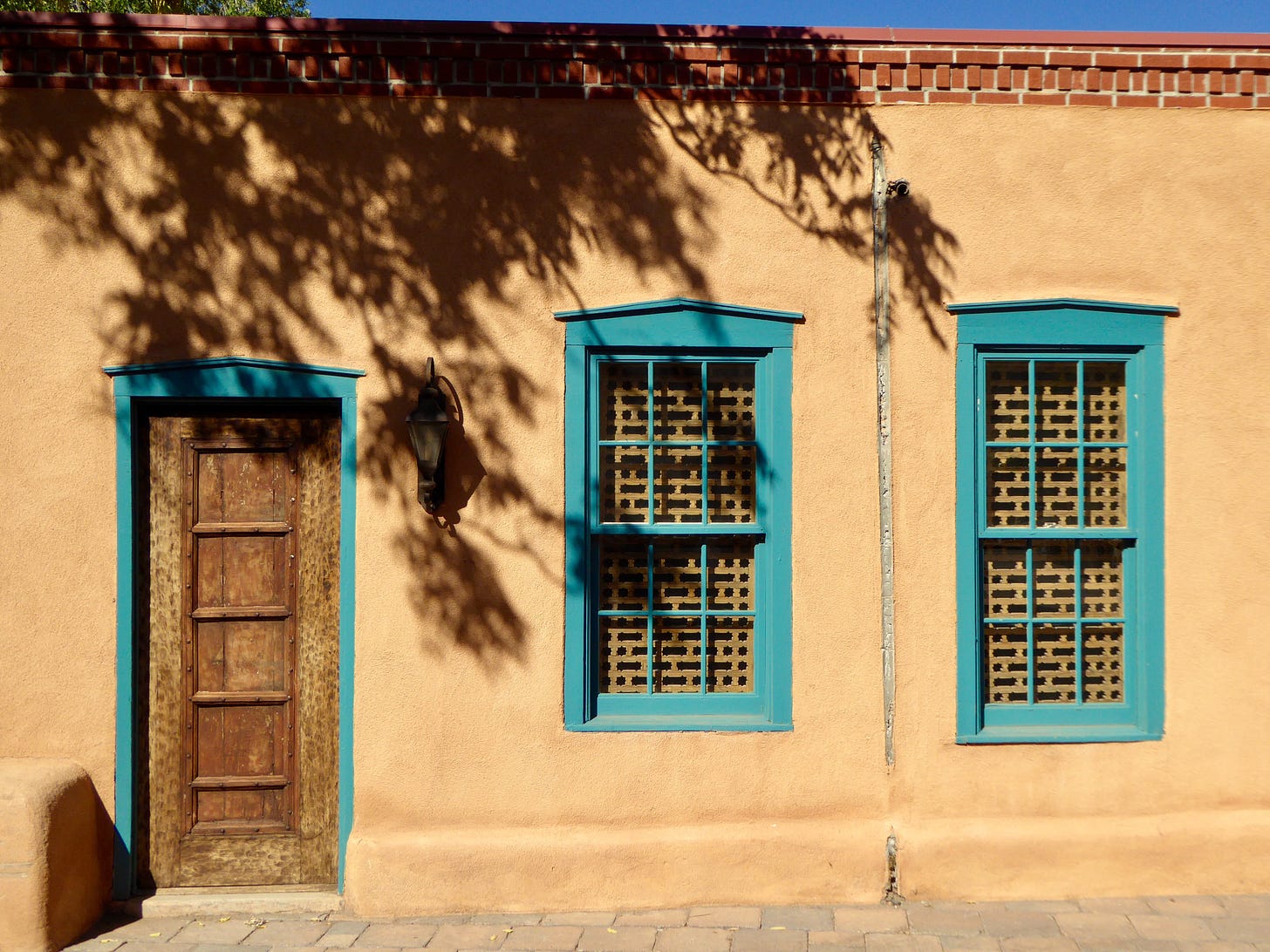Natural Building | Issue #8

I’m so happy you are here, reading this eighth issue of Placeful!
Lucky for all of us, there are so many ways to connect to the places that we live. Some of the ways that we do this, such as on going for an “awe walk,” or learning about local flora, can be done over a short scale of time. Some take much longer, and require a lot more resources.
The Built Environment & Emotion
Ever since I can remember, I have preferred the outdoors to indoors. I live for indoor/outdoor spaces and frequently find myself opening the door and stepping outside for just a few seconds, or subconsciously walking to a window to look out when I need a break from computer work.
Natural spaces are soothing, and in times of stress, it makes sense that we would turn to them. In spaces that are designed in such a way that the distinction between indoors and outdoors is less defined, we feel better. That is why, when the pandemic hit, the house plant industry was one of the industries that saw a boom in business. Natural spaces are good for our physical and mental well-being, so it makes sense that we should be attracted to natural designs.
I believe this is also why humans find architectural design that includes more curves and fewer sharp corners more inviting and less threatening. We aren’t evolutionarily accustomed to living in sharp-cornered boxes.
So what do these natural tendencies mean for practicing placefulness?
The built vs. natural environment—where is the line?
The built environment is one way that humans have connected to the earth for millennia. Not just connecting to it, but playing an active role in how it is shaped. Just like birds build their nests, and beavers build dams, and ants build anthills, humans play a part in the movement of the earth’s materials for the purpose of building our homes—and a rather large part at that:
According to the Worldwatch Institute, buildings account for 40 percent of the material resource flows through the global economy and 40 percent of all the energy used. Humans, as a result of mining activity alone, now move more material on the face of Earth than all the world’s rivers. -David Eisenberg , Living Homes: Sustainable Architecture & Design, 2001
The scale of our impact on the earth’s resources—or using less capitalist terminology, the earth’s gifts—is enormous. That means that there is a huge opportunity to make a positive change.
Connecting to our local environment does not have to happen outside the confines of our homes, schools, or other structures. In fact, this ideology can be built into the very nature of the structures that house us from the outset.
Architecture shapes—and is shaped by—our worldview
In our day-to-day lives, many Americans feel a compulsion towards productivity. A moment of rest is a moment that, for many of us, is time wasted not bettering ourselves or earning an income. There is a long sociocultural history for this attitude—that is totally fascinating, and I would love to talk about it with someone!—and it has spilled over into the way that we design our homes and cities. Function is almost always prioritized over form, and efficiency is prized over livability. Homes are built quickly and uniformly, and their inhabitants trade them out every few years for a newer one in a better location, or with more storage space, or closer to our jobs (that we change just as frequently).
This is a facet of modern life that we all understand to be normal, but for most of human history, it was not normal. Homes were traditionally built to be lived in for multiple generations of one family. They were made out of natural materials that could be found locally and used without significant detriment to their local environment, which was relied upon to feed and support them.
One response to our modern day tendencies is natural building. Principles of natural building include using locally abundant materials and working within climatic and geologic boundaries to create healthy environments for the people residing in them and the places they exist. This is achieved through beautiful form combined with appropriate function.


Natural building is a subject that I am admittedly NOT an expert in. But I find it fascinating, and a completely sensical response, or rather return, to a way of thinking about the structures that house us in a way that puts us in coexistance with the natural environment, not in defiance of it. Adobe, straw bale, rammed earth, cob—these are made from materials that come from the earth in abundance, and can be returned to the earth when the lifespan of a structure has reached its end.
One-third of the world’s population is housed in modern industrial buildings, whose materials are shipped and processed and transformed in multiple ways before they reach their end point in structures that frequently lack a connection to the local environment, and often do a poor job at sparking an emotional attachment from their inhabitants. What will happen if the remaining two-thirds of people not currently housed in modern structures—or housed at all, which is the case for millions—strive for the unsustainable model of architecture currently in practice? The realm of architectural design needs to shift its focus to making sustainable designs the norm, and make a compelling case to the broader public for the long-term cost-benefit of natural building.


Many of us do not have the resources to build a new home using these principles, but building an awareness can help us as a society move towards resource-use practices that value cradle-to-cradle design in the built environment and in other areas of our lives. Who knows when any of us will be in the position to influence zoning practices and building codes that can bring more of these practices into the mainstream.
As I said above, architecture both shapes and is shaped by our world views. Perhaps as designers, craftspeople, and laypeople continue to build momentum for natural design, we can create a positive feedback loop that furthers our goal of sustainability in all facets of life.
As humans, we can choose to separate ourselves from the natural environment through design, or we can choose to connect with it. Natural building is a move toward the latter.
With love,
Emily

(Photo cred: @mbriney on Unsplash)
Placeful Practice
Building an entirely new naturally-built home is out of the question for many folks, but there are other ways to incorporate cradle-to-cradle design into our lives. Just as synthetic materials used in homes cannot return to the earth when their functional purpose is complete, many of the products we use in our everyday lives are also destined for a similar fate.
Explore the concept of cradle-to-cradle design, and think about one shift you could make in your own life to support companies, designers, movements, or local solutions that help us live more sustainably within our communities.
Or, if you want to learn more about (or support) natural building efforts, check out Community Rebuilds, a nonprofit local to Moab that builds affordable, energy-efficient strawbale homes for local residents while training aspiring green design students!
Have a friend who is a sustainability advocate? A sibling who recently moved and is looking to learn about their new neighborhood? I would love if you’d share Placeful with them! Word-of-mouth is the most effective way to grow my newsletter, and your participation in that process would mean so much to me <3
Have any follow-up thoughts (or corrections!) regarding natural building? Click below 👇
As always, you can find this issue and previous issues of Placeful at this link. And if you want to see next week’s issue in your email inbox…



